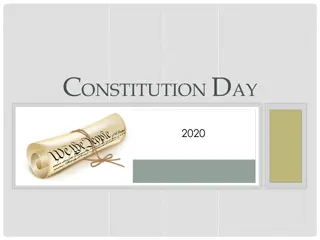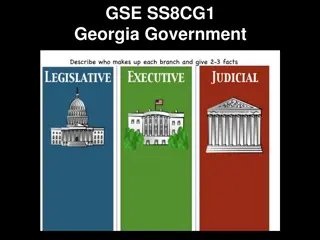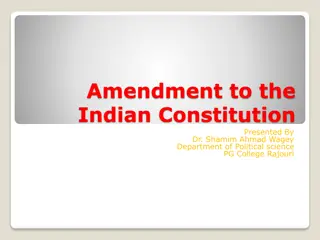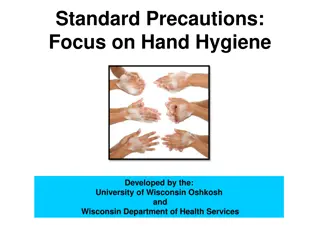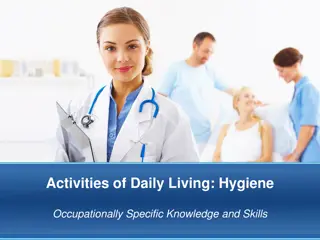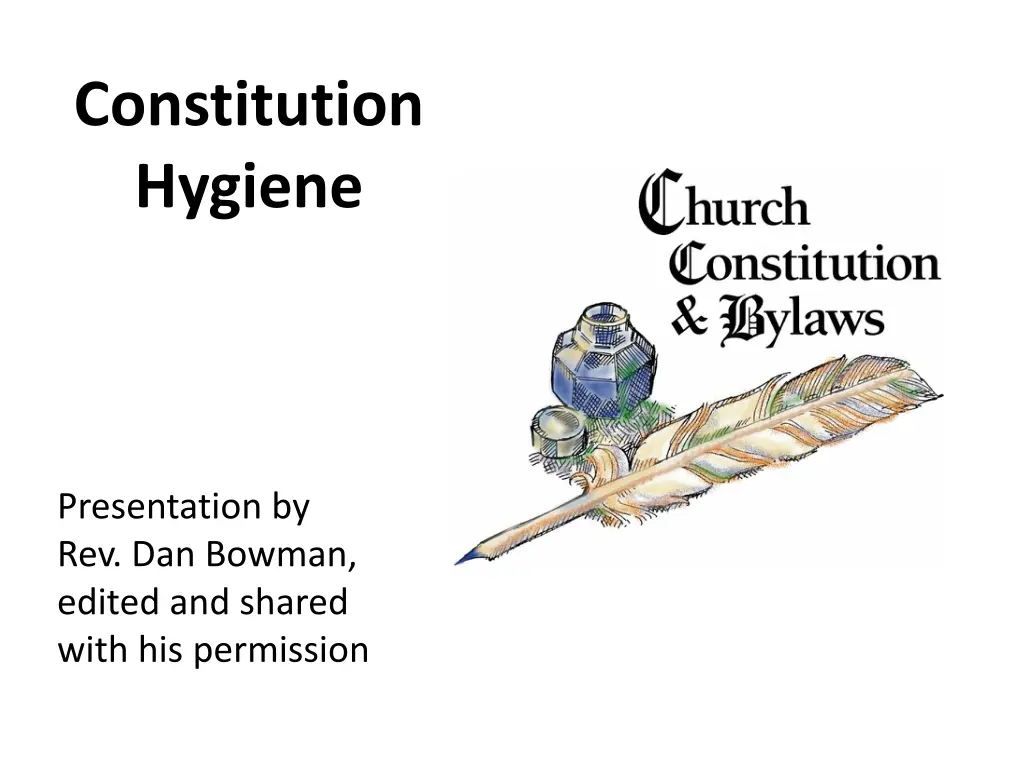
Understanding Governing Documents for Churches
Explore the importance of governing documents for churches, including constitutions, bylaws, and more. Learn why they are essential, how to update them, and the required provisions to consider.
Download Presentation

Please find below an Image/Link to download the presentation.
The content on the website is provided AS IS for your information and personal use only. It may not be sold, licensed, or shared on other websites without obtaining consent from the author. If you encounter any issues during the download, it is possible that the publisher has removed the file from their server.
You are allowed to download the files provided on this website for personal or commercial use, subject to the condition that they are used lawfully. All files are the property of their respective owners.
The content on the website is provided AS IS for your information and personal use only. It may not be sold, licensed, or shared on other websites without obtaining consent from the author.
E N D
Presentation Transcript
Constitution Hygiene Presentation by Rev. Dan Bowman, edited and shared with his permission
Governing Documents Governing Documents 1. Articles of Incorporation a document given to state when organization started for tax exempt status. Older congregations were incorporated under MN Statute 315; more recent congregations under MN Statute 317A 2. Constitution normally based on the ELCA Model Constitution for Congregations fundamentals that are more difficult to change 3. Bylaws rules that define how the church works that can be changed only by the congregation easier to change than a constitution 4. Continuing resolutions policies that could easily change can also be modified by congregation council (2/3 vote)
Why do we need Why do we need governing documents? governing documents? Like an operating manual for the church Encapsulates the fundamental beliefs of the church Unites us with other congregations of the ELCA Provides the guidelines, boundaries, and protections for effective ministry Most important when ministry is broken or when there are challenges to our faith and practice
Getting Started Getting Started 1. 2. Identify when your church constitution was last changed. If pre-1991, you will likely need two meetings to bring about the changes. Pay attention to what your current constitution says about amendments. If post-1991, you likely have a simplified and expedited process to amend required (marked with an asterisk [*]) and suggested provisions. Download from www.elca.org resources: a. LatestModel Constitution for Congregations b. Latest amendments to the Model Constitution for Congregations c. Guide for Use of the Model Constitution for Congregations Send the Request for Assistance to Update Our Constitution form to the synod office. A mentor will be assigned to work with you. 3. 4. 5.
What are required/suggested provisions? What are required/suggested provisions? Level 1 super mandatory apply whether the ELCA congregation has them in the constitution or not no exemption. In the ELCA constitution they are: 9.21. - recognition and reception of congregations 9.62. - process for termination of a congregation s relationship with this church 7.46. - calling of a pastor and the termination of such a call Level 2 mandatory exemptions may be made rarely for good cause, allowing certain sections of an existing document to be grandfathered in. In most cases, items marked with an asterisk (*) cannot be changed and must be incorporated into any constitution being amended. Level 3 suggested by the model may be changed, taking local situations into consideration. These items do not have an asterisk, but that does not mean the item can be deleted.
Consider Your Options Consider Your Options Do you want to present all revisions at one time? OR Do you want to present required amendments at one meeting, then present optional amendments, other revisions at the next meeting? OR Do you want to present required amendments at one meeting, present optional and/or additional amendments at another meeting, then present revisions to bylaws and continuing resolutions at a third meeting?
A Suggested Procedure A Suggested Procedure 1. Form a small committee to look at the 3 resources downloaded earlier as well as the congregation s current constitution, bylaws, and continuing resolutions. Repeat: unless your amendments will be simple and straightforward, it is strongly recommended that you contact the synod at the outset of your work. A Governing Documents Committee mentor will be assigned to help guide you through the process. 2. Prepare a draft of revisions: use underline for additions and strikethrough for deletions to show how the current document will change.
3. For other than mandatory changes, ask questions and share draft revisions with your Governing Documents Committee mentor for possible edits. 4. When complete, present suggested revisions to your congregation council (more than 30 days before congregation meeting for amendments that bring your constitution into conformity with the model, if you are on the fast-track; 60 days before congregation meeting for other amendments and bylaws see Chapters 16 and 17.) 5. Council votes and forwards recommendation to the congregation together with the draft.
6. Send to all member households at least 30 days before the congregation meeting (*C16.01.). This could be a separate mailing, in your monthly newsletter, or by electronic means if that provision is in your constitution. It would be helpful to summarize the changes on a separate sheet. 7. OPTIONAL You may have a Sunday morning discussion of amendments a few weeks before the congregation meeting. 8. Present the revisions at the congregation meeting. (Be sure the president has this item on the agenda.) Vote. 9. Continuing resolutions may be enacted or amended by congregation council (2/3 vote) or by the congregation (majority vote).
10. The secretary of the congregation council sends adopted amendments to the synod for final approval (*C16.03.) along with a copy of the amended constitution in its entirety. Bylaws do not need to be approved by the synod, but must be sent to be sure they do not conflict with the constitution (*C17.04.). Continuing resolutions do not need to be sent to the synod, but must not conflict with the constitution.
When to Submit to Synod When to Submit to Synod Case scenario 1: A constitution committee completes work on the document, submits to the congregation council, and then submits to the congregation for a vote. The changes are adopted, and the second year, presented without change and ratified. The secretary dutifully presents the document to the synod for review and errors are found. The document is not approved. Suggestions for change are given and sent back. The angry congregation goes back to the beginning of the process. It takes two more meetings to approve the documents. For some congregations, a constitutional amendment can be considered only at an annual meeting. Total time to process the changes: four years.
When to Submit to Synod When to Submit to Synod Case scenario 2: A constitution committee works with the Governing Documents Committee mentor through the process to answer questions, make editorial changes, and to complete work on the document. The amendments are submitted to the congregation council, then to the members before the congregation vote. The amendments are adopted. The secretary dutifully presents the document to the synod for review. The document is approved and the congregation is notified. With the second vote, if needed, the amended constitution is presented without change and ratified. The happy congregation has completed the process. For some congregations, a constitutional amendment can be considered only at an annual meeting. Total time to process the changes: two years.
Constitution Committee Checklist Constitution Committee Checklist All required provisions as of the time of the first vote have been included without any changes except where an option is given. The asterisk (*) is maintained throughout so all reading the document know the language is required. The proper name of the Southeastern Minnesota Synod is used throughout the document. All references to MODEL constitution have been replaced with our congregation s name and location. The council is consistently identified as Congregation Council. ( Church Council refers to the council of the ELCA churchwide organization.) Numbering, even in non-mandatory provisions, is consistent with the model. Numbers omitted by design in the model haven t been fixed , nor has there been any re- ordering of items. Any new chapters have been added after Chapter 20.
Language has been selected and brackets removed wherever options have been [offered] [presented]. All blanks have been filled in with appropriate information. Wherever the constitution makes reference to a bylaw, that bylaw has been appropriately written. The quorum for congregation and council meetings has been clearly defined. There are no inconsistencies with the congregation s name in the Articles of Incorporation. We have retained C12.05. in its entirety stating the congregation council is the board of We have included the codification explanation, page numbers, and dates of prior amendments. Our Policies & Procedures mentor knows the date we plan to have our congregation vote to adopt these amendments.
Formatting Suggestions Formatting Suggestions Items in a series proper protocol is to use numerals (1. 2. 3.) for items that can be separated from each other (such as a job description) and list items with letters (a. b. c.) for matters that should not be separated. The Southeastern Minnesota Synod suggests using bold print for constitutional items, light print for bylaws, and italics for continuing resolutions. An alternative might be regular print for constitutional items, italics for bylaws, and compressed (and/or smaller) print for continuing resolutions. It is also important to follow the codification suggestions given in the introduction to the model. Therefore, prefacing a bylaw item with B (B12.02.01.) is inconsistent with the model s suggested C12.02.01. The C in the number stands for Congregation, not Constitution. Synod constitution items are prefaced with S .
Embodying Bylaws and Embodying Bylaws and Continuing Resolutions Continuing Resolutions Have you been a part of a meeting where a question was raised similar to, How much did we decide the cemetery plats should be and when did we decide that? Placing bylaws and continuing resolutions in the appropriate section in the constitution allows related documents to be seen together. It would be very helpful for the secretary to inventory any past council or congregation decisions that have ongoing effect and make them available to the committee working on the amendments for inclusion, preferably within the document rather than at the end. Adding these in the comprehensive index would make them accessible to everyone.
Bylaws vs. Continuing Resolutions Bylaws vs. Continuing Resolutions If a congregation passes a resolution relating to how ministry happens in that place, that is likely a continuing resolution. If the congregation wants to retain any authority for changes in that resolution, it should be added as a bylaw. Otherwise, the congregation council has the authority to make changes in that continuing resolution with a 2/3 vote. Examples of continuing resolutions: Confirmation requirements; cemetery rules; committee, board, or team job descriptions; scholarship requirements; rules on how an endowment can be used; who is active and who is inactive ; rules on terminating membership; facility use rules and costs; rules for weddings.
Helpful Hygiene Tasks Helpful Hygiene Tasks (requiring no approval) (requiring no approval) 1. On page 1, include name of the congregation, city and state, and the date of the latest revision so you can see that you are looking at the most current version. 2. On page 2 place a table of contents with the chapter headings as the main level and bylaws and continuing resolutions (if incorporated) as sub-levels. 3. Add a codification explanation (see the model constitution). 4. Include a list of dates the constitution has been amended by the congregation and approved by the synod at the end of the constitution.




